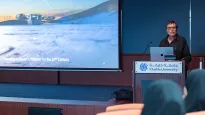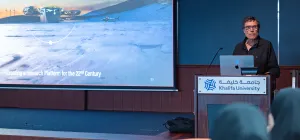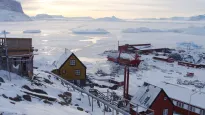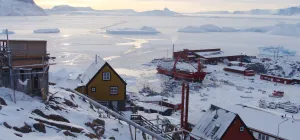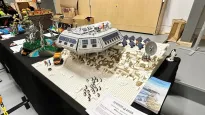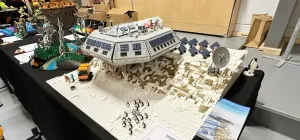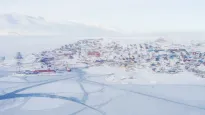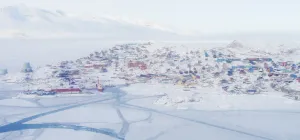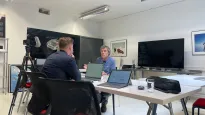Jan Lenaerts reflects on 2014-15 season, looks ahead to next

InBev-Baillet Latour Antarctica Fellowship laureate Jan Lenaerts reflects on the time he spent in Antarctica on the King Baudouin Ice Shelf conducting research for the BENEMELT project and discusses plans for next season.
How was your season in Antarctica? Did you accomplish everything you set out to accomplish?
In terms of scientific research, I’m very happy. I accomplished everything I planned to do this past season, so I’m more than satisfied.
How was adjusting to life in Antarctica for you?
It was a rather smooth adjustment when I went there. But it’s a different world. You’re completely secluded form normal life, especially when you’re doing field research. You have no internet connection, no phone, no way to communicate with the outside world all the time. It’s another rhythm of life. You’re just a group of scientists. It makes life very regular, and very simple in a way.
How was it adjusting to life after you came back?
When you return, you immediately find yourself back in the normal world all of a sudden. It takes some time to get used to all that again.
It’s also kind of strange when you go to Antarctica and you’re confronted with 24-hour daylight. I liked it a lot. I didn’t have a problem to sleep or anything.
It was only hard once I got back to Europe in the heart of winter that I had difficultly. It was a bit depressing. All of a sudden, I was missing the sunlight. It’s not only the number of hours of daylight - which is low in Northern Europe in winter - but also the intensity of the sunlight. In the Netherlands, it’s dark, grey and humid, while in Antarctica, it’s very sunny and bright most of the time.
So you prefer the sun?
I prefer the sun, and I also prefer the cold. That’s what’s very attractive about Antarctica. Antarctica is a place where you can have the sun and the cold at the same time - at least during the austral summer.
What have you done for the BENEMELT research project since returning?
I’ve been trying to automatically link via satellite the data coming from the automatic weather station I set up on the King Baudouin Ice Shelf this past season under the BENEMELT project blog. This means that near realtime data is plotted on this blog. I and everyone who is interested can follow weather conditions on the King Baudouin Ice Shelf.
The weather station has been operational for more than a month now, and it seems that there’s a lot going on in terms of melt. It’s quite impressive. There are a lot of days where temperatures are above freezing during the day. Over the past month, there have only been about 10 days where the temperature has been below 0°C on the ice shelf. So it’s a relatively warm place - considering it’s Antarctica in the summer.
What about the firn cores you extracted?
I took eight firn cores during the field expedition, and I’ve already managed to digitize the data I recovered from those cores (ice density and the position of each of the ice layers in the firn cores). So now I can start to plot the data on graphs and analyze the data.
To be honest, I’ve got a lot of work to do outside of the BENEMELT project. I just need to find time to analyze the data.
Has the King Baudouin Ice Shelf turned out to be warmer than you expected?
Before going there, I had had a few hypotheses. Based on satellite data and my intuition, I suspected that there would be the largest gradient in surface melting of the ice shelf along a transect between the coast and the grounding line of the ice shelf (where the ice sheet ends and the ice shelf begins). This turned out to be true. I observed that there was a huge change in snow conditions travelling from the coast towards the grounding line.
During the expedition, we spent four days at the grounding line. It was extremely nice weather - not a lot of wind and warm. In fact, it was 5°C the day I set up the automatic weather station. I didn’t know what to expect in terms of temperature. But from the data I’ve collected, surface melt appears to be very active on the King Baudouin Ice Shelf near the grounding line.
I’m surprised that the melt is as continuous as it is. It’s not just happening for a few days during the summer. It’s happening for more than a few days - at least this year. We know there’s a lot of variability from year to year in terms of melting. But we can say that this past season was warm on the King Baudouin Ice Shelf.
What’s also striking is that almost every day we had very nice weather on the ice shelf - sunny and not a lot of wind.
You experienced a rough storm when you were out on the ice shelf, though. Will the automatic weather station (AWS) be able to hold up?
Because it melts and then re-freezes repeatedly, the snow on the surface of the ice shelf is very hard and dense. When we set up the AWS, we dug a big 60 cm-deep hole in the snow surface. We put the AWS in there and filled up the hole around it with lots of snow. And as the melt / refreeze cycle continues, the station will become more and more fixed into the ice. So I’m quite sure the AWS is stable. The only problem is that it will be a challenge when we have to dig out the station next season.
Speaking of next season, what is your plan for BENEMELT project when you return at the end of 2015?
I’m planning to have a detailed discussion with my colleagues on this, but my plan is to go back to the grounding line, close to where the AWS is, and camp there for a few weeks so we can measure in detail the interaction between the snow and the surface melt.
We’ll bring instruments that can measure snow albedo (how much the snow reflects the sun’s energy) in detail. We’ll also bring instruments that can measure snow temperature. We plan to make a hole inside the snow and put some temperature sensors inside the snow at the surface, and others more deeply into the snow, so we can get a vertical temperature profile of the snow.
We’re also bringing instruments that can measure the size of snow particles. I suspect that the size and the shape of snow particles near the surface changes when there’s surface melt going on.
So compared to the season I just finished, which aimed to get an idea spatial and temporal variability of melting across the King Baudoin Ice Sheet, next season we’ll be doing a lot more detailed observations in one place, at the grounding line, where the AWS is. This seems to be a very interesting spot to investigate. There seems to be a lot going on in terms of melt activity.
I understand you’re also very interested in paying a visit to the mysterious circular structure on the King Baudouin Ice Shelf that the team of geophysicists from the Alfred Wegener Institute discovered during their geological survey.
My colleagues and I have a lot of interest in visiting this feature next season. We think it’s an ice doline - which forms from snow at the surface melting, re-freezing and draining form the ice shelf, but we have to verify this hypothesis in the field.
Overall, how did you find the quality of the logistical support given to your research project this season?
I’d have to say thumbs up to everyone involved. The station team took care of all of our logistical needs as scientists.
Download












